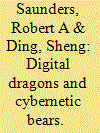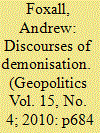|
|
|
Sort Order |
|
|
|
Items / Page
|
|
|
|
|
|
|
| Srl | Item |
| 1 |
ID:
072118


|
|
|
|
|
| Publication |
2006.
|
| Summary/Abstract |
This article compares and contrasts the Internet-based national identity projects of overseas Chinese and near abroad Russians. Our study, which is based on two diasporic communities of similar size and both characterized by a historical weakness of national identity, finds that while Internet use seems to be increasing nationalism and reifying national identity among the ethnic Chinese living in the Pacific Rim, it is paradoxically dampening nationalism and weakening national identity among the Russians living in post-Soviet space. Our thesis is that this divergence results from a combination of factors rooted in the real world, not the virtual. These factors include: the perceived benefits of stressing national identity in ingroup/outgroup interactions, conflicts or competition with other identity anchors, and the political and economic stature of their respective ethnic homelands.
|
|
|
|
|
|
|
|
|
|
|
|
|
|
|
|
| 2 |
ID:
101103


|
|
|
|
|
| Publication |
2010.
|
| Summary/Abstract |
In the summer of 2007, the geopolitics of Russo-North Caucasian relations were once again manifest in inter-ethnic violence. During the course of six weeks of rioting between ethnic Russian (russkii) and non-ethnic Russian (rossiiskii) citizens, three students were killed (one Chechen and two Russians) and pogroms were conducted widely. This article addresses these events through a focus on the nature and politics of the riots and those involved. I argue that a range of tensions came together to form a localised geopolitics, and that this contributes to an understanding of why these events took place. Ultimately, the riots are important as an event which reveals much about the complexity of power, space, and identity in contemporary Russia.
|
|
|
|
|
|
|
|
|
|
|
|
|
|
|
|
| 3 |
ID:
075391


|
|
|
|
|
| Publication |
2006.
|
| Summary/Abstract |
The Solon tribes, including the Oroqen, the Ewenk and the Daur, have lived in Heilongjiang (North Manchuria) for millennia. For centuries, the Solon led a hunting life in the mountains and along the rivers. Their constant migration earned them a reputation as nomads. Russian penetration into the region in the late nineteenth century Russified many of the Solon, which alarmed the Chinese government into action. The Chinese persistently embraced every opportunity to win them over. The principal policy adopted by both the Qing dynasty and the Chinese Republic was to turn Solon nomads into sedentary farmers. The government erected villages for the Solon, helped them to adapt to new life, and educated them to be Chinese citizens. These paternalistic yet preferential measures, however, rapidly Sinicized the Solon in just three decades.
|
|
|
|
|
|
|
|
|
|
|
|
|
|
|
|
| 4 |
ID:
149721


|
|
|
|
|
| Summary/Abstract |
THE REASONS behind the breakup of the USSR have been discussed in a lot of research papers, which, stacked together, could reach the Moon. However, few authors noted that, apart from the economic and political reasons behind this breakup, it was civilizational incompatibility of the country's separate parts that greatly impacted the disintegration of the USSR. On the one hand, the Soviet Union comprised Western-style modern Moscow, Leningrad (St. Petersburg), Novosibirsk, Kiev, Kharkov, Lvov, Vilnius, Riga, Tallinn, Tbilisi, and Yerevan, while on the other, Central Asia, Azerbaijan (except for the cosmopolitan Baku), Islamic enclaves of the North Caucasus and Volga region, all of which outwardly accepted the Soviet way of life, while continuing to live under the medieval Sharia laws. The 15th and 20th centuries have been forcefully united in one state which has dumped the old deities, elevated the new ones as personified by communist leaders and declared the victory of atheism.
|
|
|
|
|
|
|
|
|
|
|
|
|
|
|
|
|
|
|
|
|